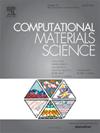Low lattice thermal conductance of buckled GeTe/antimonene vdW interface device: A DFT + NEGF study
IF 3.1
3区 材料科学
Q2 MATERIALS SCIENCE, MULTIDISCIPLINARY
引用次数: 0
Abstract
Motivated by the exceptional thermoelectric performance of 2D buckled GeTe and Sb monolayers, thermoelectric transport characteristics of the stable GeTe/Antimonene (Sb) van der Waals heterostructure (vdWH) are examined by first-principles calculations supplemented by the non-equilibrium Green’s function approach (NEGF). The electronic aspects of these thermoelectric devices are assessed by reviewing the Seebeck coefficient (S) and electrical conductance (Ge) derived from transmission spectra. Simultaneously, the thermal conductance (κph) of the system was computed by analysing the lattice/phonon transmission spectrum. The thermoelectric figure of merit (ZT) for the system is calculated by integrating the electron and phonon transmission spectra across various chemical potentials (μ) and temperatures (T). In this context, the heterostructure featuring a smaller interlayer vdw gap and reduced phonon thermal conductance ultimately exhibits superior thermoelectric performance. The effective phonon scattering at the interface establishes reduced phonon thermal conductance at the heterostructure. At 300 K, low phonon thermal conductance attains 43.23 pW/K and the highest ZT attains 6.97 for heterostructure. Our theoretical research provides an innovative technique and offers valuable theoretical insights into the thermoelectric transport properties of vdW heterostructures device.

求助全文
约1分钟内获得全文
求助全文
来源期刊

Computational Materials Science
工程技术-材料科学:综合
CiteScore
6.50
自引率
6.10%
发文量
665
审稿时长
26 days
期刊介绍:
The goal of Computational Materials Science is to report on results that provide new or unique insights into, or significantly expand our understanding of, the properties of materials or phenomena associated with their design, synthesis, processing, characterization, and utilization. To be relevant to the journal, the results should be applied or applicable to specific material systems that are discussed within the submission.
 求助内容:
求助内容: 应助结果提醒方式:
应助结果提醒方式:


